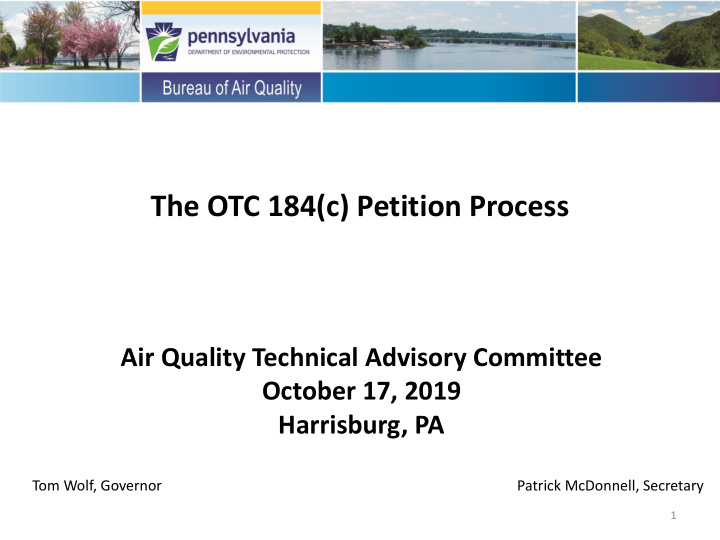



The OTC 184(c) Petition Process Air Quality Technical Advisory Committee October 17, 2019 Harrisburg, PA Tom Wolf, Governor Patrick McDonnell, Secretary 1
OTC 184(c) Overview What is a 184(c) Petition? • Under Section 184(c) of the Clean Air Act, any State within the Ozone Transport Region (OTR) may petition the Ozone Transport Commission (OTC) to develop, after notice and opportunity for public comment, recommendations for additional control measures to be applied within all or a part of the OTR if the OTC determines such measures are necessary to bring any area in the OTR into attainment by the dates provided by the CAA.
OTC 184(c) Overview How did OTC’s 184 (C) petition begin? • On May 30, 2019, Maryland petitioned the OTC under CAA Section 184(c). The Maryland petition may be viewed at: https://otcair.org/ or https://mde.maryland.gov/programs/Air/Pages/index.aspx. • The petition asked the OTC to consider developing additional control measures within part of the OTR, specifically the potential need for daily limits at coal-fired Electric Generating Units (EGUs) in Pennsylvania, as necessary to bring areas in the OTR into attainment by the dates mandated by the CAA.
OTC 184(c) Overview The OTC votes to move forward with 184(c) petition process. • On June 26, 2019, the OTC voted to proceed with the initial steps associated with CAA Section 184(c) petition process, including analyzing recent coal-fired EGU operations in Pennsylvania. • The OTC held a public hearing on August 16, 2019. Sixteen commenters provided testimony or sent written comments. Testimony and comments may be reviewed at: https://otcair.org/document.asp?fview=meeting • DEP testified in opposition to the petition. • In addition to DEP’s testimony, eight commenters opposed the petition. • Seven commenters supported Maryland’s petition.
OTC 184(c) Overview DEP’s opposition to an OTC 184(c) petition is based upon the following: • The U.S. Environmental Protection Agency (EPA) has denied action on similar 126 petitions from four of the OTC states for these same units. • EPA found that the identified sources were not emitting, and were not expected to emit, pollution in violation of the Clean Air Act good neighbor provision for either the 2008 or 2015 ozone NAAQS. • EPA determined that the identified facilities consistently operate their Selective Catalytic Reduction – or • SCR – controls throughout the ozone season and that the SCRs are turned down or off during periods of low generation, which most likely does not occur during peak ozone formation times in the afternoon hours. • EPA stated that existing controls on the identified sources have already been optimized under the Cross- State Air Pollution Rule Update, and therefore, there are no additional control strategies available to further reduce NOx emissions at these sources to address the 2015 NAAQS. • DEP will also re-evaluate RACT for the 2015 Ozone Standard as required by the CAA.
Overview OTC 184(c) Process Flow Chart
Overview OTC Moves Forward with 184 (c) Petition Process • On October 4, 2019, the OTC Commissioners voted to move forward with the 184(c) petition process and move the OTC petition for a final public comment period. • Pennsylvania voted against the petition process, Virginia and New York abstained, and the remainder of the OTC members voted to move forward. • The proposed petition would OTC recommend that EPA require Pennsylvania to adopt and implement daily NOx limits as expeditiously as practicable. • OTC is suggesting that three options embodied in the Delaware, New Jersey and Maryland regulations will provide Pennsylvania with the flexibility to implement daily NOx limits. • OTC has indicated that the recommendation does not involve the purchase or installation of new control technologies, thus the OTC urges EPA to require that Pennsylvania implement these requirements in time to reduce ozone levels during the summers of 2020 and 2021.
Contact Information: Krishnan Ramamurthy at 717-772-2725 8
Recommend
More recommend